#syllabic alphabet
Text
The Evolution of the Alphabet: A Story of Human Ingenuity and Innovation 🤯
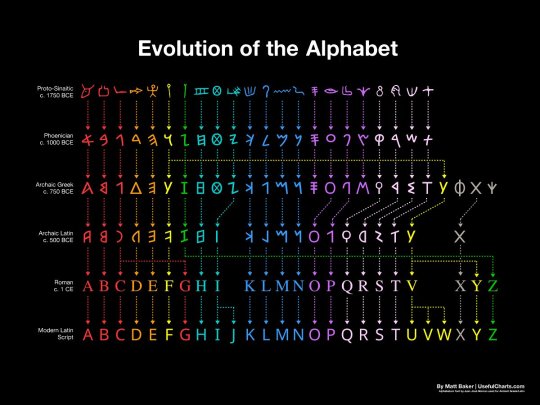
How the Alphabet Changed the World: A 3,800-Year Journey
The evolution of the alphabet over 3,800 years is a long and complex story. It begins with the ancient Egyptian hieroglyphs, which were a complex system of pictograms and ideograms that could be used to represent words, sounds, or concepts. Over time, the hieroglyphs were simplified and adapted to represent only sounds, resulting in the first true alphabets.
The first alphabets were developed in the Middle East, and the Phoenician alphabet is considered to be the direct ancestor of the Latin alphabet. The Phoenician alphabet had 22 letters, each of which represented a single consonant sound. This was a major breakthrough, as it made it much easier to write and read.
The Phoenician alphabet was adopted by the Greeks, who added vowels to the system. The Greek alphabet was then adopted by the Romans, who made some further changes to the letters. The Latin alphabet, as we know it today, is essentially the same as the Roman alphabet, with a few minor modifications.
The English alphabet is derived from the Latin alphabet, but it has undergone some further changes over the centuries. For example, the letters "J" and "U" were added to the English alphabet in the Middle Ages, and the letter "W" was added in the 16th century.
The evolution of the alphabet has had a profound impact on human history. It has made it possible to record and transmit knowledge, ideas, and stories from one generation to the next. It has also helped to facilitate communication and trade between different cultures.
The alphabets are a fascinating invention that have revolutionized the way humans communicate and record information. The history of the alphabets spans over 3,800 years, tracing its origins from the ancient Egyptian hieroglyphs to the modern English letters.

Here is a brief overview of how the alphabets have evolved over time:
Egyptian hieroglyphs (c. 3200 BC): The earliest form of writing was the pictographic system, which used symbols to represent objects or concepts. The ancient Egyptians developed a complex system of hieroglyphs, which combined pictograms, ideograms, and phonograms to write their language. Hieroglyphs were mainly used for religious and monumental purposes, and were carved on stone, wood, or metal.
Proto-Sinaitic script (c. 1750 BC): Around 2000 BCE, a group of Semitic workers in Egypt adapted some of the hieroglyphs to create a simpler and more flexible writing system that could represent the sounds of their language. This was the first consonantal alphabet, or abjad, which used symbols to write only consonants, leaving the vowels to be inferred by the reader. This alphabet is also known as the Proto-Sinaitic script, because it was discovered in the Sinai Peninsula.
Phoenician alphabet (c. 1000 BC): A consonantal alphabet with 22 letters, each of which represented a single consonant sound. The Proto-Sinaitic script spread to other regions through trade and migration, and gave rise to several variants, such as the Phoenician, Aramaic, Hebrew, and South Arabian alphabets. These alphabets were used by various Semitic peoples to write their languages, and were also adopted and modified by other cultures, such as the Greeks, Etruscans, and Romans.
Greek alphabet (c. 750 BC): The Greek alphabet was the first to introduce symbols for vowels, making it a true alphabet that could represent any sound in the language. The Greek alphabet was derived from the Phoenician alphabet around the 8th century BCE, and added new letters for vowel sounds that were not present in Phoenician. The Greek alphabet also introduced different forms of writing, such as uppercase and lowercase letters, and various styles, such as cursive and uncial.
Latin alphabet (c. 500 BC): The Latin alphabet was derived from the Etruscan alphabet, which was itself derived from the Greek alphabet.
Roman alphabet (c. 1 CE): The Roman alphabet is essentially the same as the Latin alphabet, as we know it today. The Latin alphabet was used by the Romans to write their language, Latin, and became the dominant writing system in Europe after the fall of the Roman Empire. The Latin alphabet was also adapted to write many other languages, such as Germanic, Celtic, Slavic, and Romance languages.
English alphabet (c. 500 AD): The English alphabet is derived from the Latin alphabet, but it has undergone some further changes over the centuries. For example, the letters "J" and "U" were added to the English alphabet in the Middle Ages, and the letter "W" was added in the 16th century. The English alphabet consists of 26 letters, but can represent more than 40 sounds with various combinations and diacritics. The English alphabet has also undergone many changes in spelling, pronunciation, and usage throughout its history.
The evolution of the alphabet is a remarkable example of human creativity and innovation that have enabled us to express ourselves in diverse and powerful ways. It is also a testament to our cultural diversity and interconnectedness, as it reflects the influences and interactions of different peoples and languages across time and space.
Thank you for reading! I hope you enjoyed the post about the evolution of the alphabet. If you did, please share it with your friends and family. 😊🙏
#evolution of the alphabet#history of writing#alphabet#hieroglyphs#proto-sinaitic script#phoenician alphabet#greek alphabet#roman alphabet#english alphabet#language#linguistics#consonantal alphabet#syllabic alphabet#ancient egyptian#greek mythology
12 notes
·
View notes
Text
babygirl I can make the ugliest fucking attempt at copying down the tengwar you have ever seen
#this is a sequel to ‘babygirl I can draw the ugliest fucking hexagon you have ever seen’ which was a frequent thought (and discord status)#I had during the organic chemistry unit in high school#elli rambles#anyway I’m not planning to actually learn any elvish languages but I really love trying to learn non-latin scripts#like I know the greek alphabet (or at least the lowercase letters) the inuktitut syllabics (though I probably need to go over those again#bc I feel like I’ve forgotten them a bit)#and now the tengwar & maybe the cirth too#and I also want to learn the hebrew alphabet some time in the future
2 notes
·
View notes
Text
289 notes
·
View notes
Note
Random question:
So a while back I read something where someone was talking about how if English spelling were reformed so every sound had a unique symbol that we’d lose the “visual alliteration” of Cape Cod.
I cannot figure out what that means. Are those /k/ sounds not both [k]? The only difference I’ve been able to notice is a feeling of the airstream moving outward in “Cape” and inward in “Cod”, but I can’t tell if that’s due to vowel influence or what.
Let's back up. The "someone" who was talking about this was either (a) wrong, (b) uncooperatively pedantic, or (c) imagining a very specific, non-alphabetic spelling reform of English (e.g. spelling English with logographic or syllabic glyphs).
Assuming (b), the only way that English spelling could be reformed such that the C's in Cape Cod would be different is if the spelling reforming was as sensitive as a narrow IPA transcription. If that was the case, then there are some transcriptions of English that would transcribe the first as [kʰʲ] and the second as [kʰ]. This level is detail is phonologically important for some languages. English is not one of these. A sensible spelling reform would spell those the same, whether C (because all instances of [k] become C) or K (because all instances of [k] become K). A nonsensical spelling reform would actually spell aspirated and unaspirated voiceless stops different, but even then, these two would be the same, as they're both aspirated.
The airstream is the same for both (egressive). What you're feeling, I expect, is the very slight movement in tongue position as the initial [k], which is palatalized, moves backward to an unpalatalized position. The reason you feel this is the tongue doesn't have to do anything in between the onset of the first word and the onset of the second. The tongue gets in position for [e], and in this position you can pronounce [k] well enough, then with [p], your tongue doesn't have to do anything; the lips take care of it. This means your tongue body can remain in place. For "Cod", it moves back as the tongue prepares to pronounce [ɑ] (or whatever back vowel you have there). Notice also that the tongue body has to go down, the tongue tip retracting slightly to pronounce [ɑ]. That's all part of it.
Now, assuming (c), yeah, that's indeed going to happen. Consider Japanese katakana. This is how "Cape Cod" is spelled: ケープコッド /keːpu koddo/. The relevant characters—the ones that begin each syllable—are ケ /ke/ and コ /ko/. And, yeah, they're different, so you do lose the visual alliteration. However, what you lose in visual similarity you gain in economy. To write /ka, ke, ki, ko, ku/ in an alphabet you need 6 different letter forms and 10 total glyphs. To write the same thing in katakana you need 5 different letter forms and 5 total glyphs. Consider an old style text message, which had a hard character count. A syllabary allows you to fit more letters in than an alphabet because each character encodes more information. When it comes to sheer character count, then, the Japanese writing system is much more efficient when it comes to writing Japanese than the English Romanization is.
Of course, that's for Japanese. For English it doesn't make as much sense because of our overabundance of consonant clusters. Typing lava in an alphabet takes 4 characters; in a syllabary, it takes 2. Typing straps, though, requires 6 characters in an alphabet and 5 in a syllabary. That doesn't save you a lot space—and a syllabary like Japanese's throws in extra vowels that have to be there, even if they're not pronounced, destroying its efficiency by, essentially, adding extra noise to the signal. Returning to straps, you have 6 characters, and all elements are vocalized. In katakana, you'd have to do ストラプス /sutorapusu/. You save a character with ラ /ra/, but then you have a whole bunch of vowels you have to remember not to pronounce.
Long story short, if you were going to reform the English spelling system, I don't think a syllabary (or even an abugida) makes sense, and a logography would be quite a thing to drop on the unsuspecting populace, even if it would be more equitable. This is why I guessed that what you overheard wasn't (c) and was likely (b).
Anyway, that's my 2¢. Hope it helps.
#language#linguistics#orthography#spelling#English#Japanese#syllabary#logography#alphabet#spelling reform
70 notes
·
View notes
Text
I FOUND A THING.
I'm watching Assembled: The Making of Moon Knight, and there's a nice closeup of the chest area of the costume. I noticed something funny about the hieroglyphs on the right side of the decal.
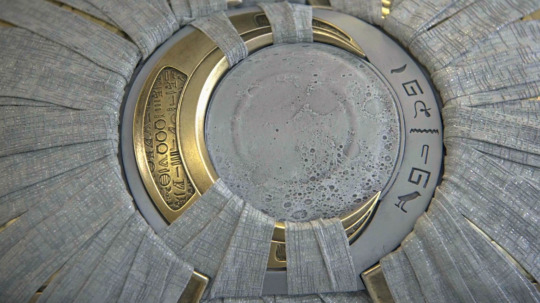
I can read hieratic, so I translated it. It was a simple alphabetic translation, not syllabic, meaning each hieroglyph corresponds to an English letter to spell an English word.
AND NO JOKE, the sandy moon pigeon himself SIGNED HIS OWN NAME on the suit.
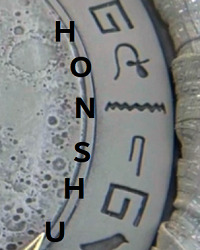
(The animal/human hieroglyphs always look toward the beginning of the text, so the quail chick should actually be facing the other way, but I'm ignoring that and assuming Ramy Romany was overridden on that decision. lol)
2K notes
·
View notes
Text
the Aurebesh isn't very great from a conscripting perspective. not only because it's a fucking cipher (a mere font to write in English, with English nonsensical spelling rules) but also because all letters are blocky squares.
Which us fine because this isn't the focus of Star Wars, it's purpose isn't to work well linguistically or practically, it is to set an atmosphere and pretend it's not English
Chinese, Japanese and other syllabic scripts work that way because each symbol stands for a while syllable, not an individual sound. and English has syllables with massive consonant clusters like scratch
an alphabet needs many tall, thin letters like l i r q r t p d f h j k l b
if all letters are fat and wide like ლ then any text occupies far too much space and is overly long. and larger chunks of text consume exponentially more space, paper, ink, digital pages, stablishment titles, etc, not to mention being annoying to read
the simplest solution is to create thinner versions of each letter, making them thinner and thinner until it's a totally different alphabet
a different solution that preserves the blocky feel is to combine letters together into ligatures, like in Hindi, specially for common words and consonant combinations, so, fusing E and R into a single ER letter, for example.
to illustrate, this is "Republic" in canon Aurebesh:

and this is "Republic" after combining some letters:

we could go more aggressive and combine more than two letters, but speakers would have to know all ligatures, but that's fine, Hindi speakers learn hundreds or millions of letter combinations and they're not random, they are intuitive
now with Skywalker:


of course, i'd still prefer to make an alphabet which actually makes sense

real life example: Korean
if we wrote English with the Hangul, Republic would be 러풉맄
[ㄹ=r][ㅓ=e][ㅍ=p][ㅜ=u][ㅂ=b][ㄹ=l][ㅣ=i][ㅋ=k]
ㄹ+ㅓ=러
ㅍ+ㅜ+ㅂ=풉
ㄹ+ㅣ+ㅋ=맄
canon Aurebesh would spell it ㄹㅓㅍㅜㅂㄹㅣㅋ
Hindi:
र=e रे=re फ=p फु=pu
ब=b ल=l ब्ल=bl ब्लि=bli ख=c
रेफुब्लिख = Republic
canon Aurebesh would spell it रएफउबलइख
#languages#alphabets#alphabet#aurebesh#star wars#ligature#ligatures#clone wars#star wars prequels#sw prequels#conscripting#conscript#worldbuild#worldbuilding#hangul#devanagari#devanāgarī#देवनागरी#한글
36 notes
·
View notes
Text
so I've been working on my latest conlang, irkan osla (or just osla for short), for a bit now and would like to showcase its writing system in this post! osla has a syllabic alphabet, not too dissimilar to korean hangul, where letters are stacked according to certain rules to make syllable blocks.
osla's syllable structure is (C)(C)V(V)(C), here's how the stacks work for each type of syllable:
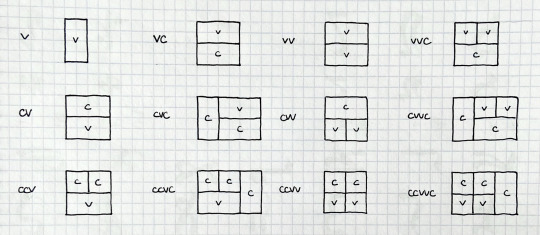
all letters have small, wide, and tall forms depending on their position in the syllable. here are all the letters with their IPA value and romanization:

and here's an example text! i translated parts of the minecraft end poem into osla. maybe i'll make another post just focusing on the grammar when it's more developed. the poem says in english:
What did this player dream?
This player dreamed of sunlight and trees. Of fire and water. It dreamed it created. And it dreamed it destroyed. It dreamed it hunted, and was hunted. It dreamed of shelter.
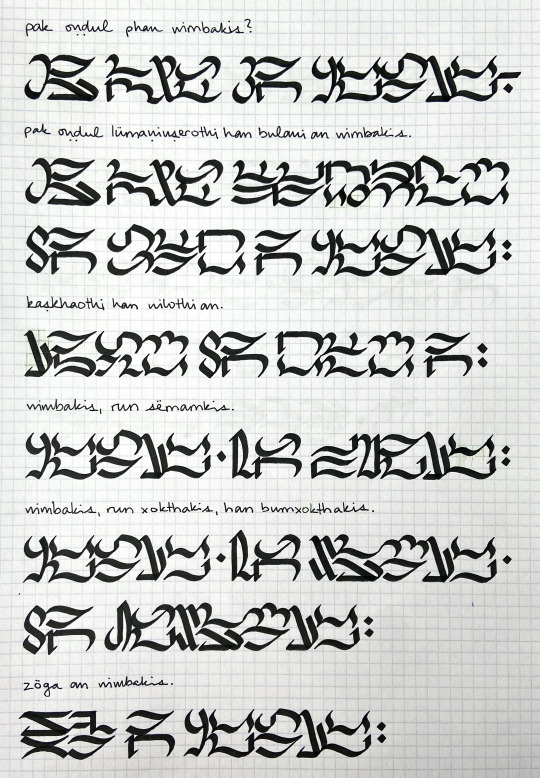
Does it know that we love it? That the universe is kind?
Sometimes, through the noise of its thoughts, it hears the universe, yes.

this post is getting long, so under the cut you'll find a "sans-serif" version as well as the poem in osla and its gloss if you're also a linguistics nerd and wanna know what's going on under the hood (the roman numerals stand for the 3 noun classes)! thanks for reading!
The way regular people would write something quickly on a piece of paper with a regular pen is an aspect of creating neographies that I feel is often overlooked, so I developed this sans-serif version that people would probably be more likely to use when writing their shopping lists or diary entries:

And, finally, here's the poem translation:
pak oṇḍul phan wimbakis?
DET.I.SG.PROX play-AGN what dream-PST.3SG.I?
pak oṇḍul lümaṇiuṣerothi han buloni an wimbakis. kaṣkhaothi han nilothi an. wimbakis, run sëmamkis. wimbakis, run xokthakis, han bumxokthakis. zöga an wimbakis.
DET.I.SG.PROX play-AGN sunlight-II.SG.DAT and tree-II.PL.DAT of dream-PST.3SG.I. Fire-II.SG.DAT and water-II.SG.DAT of. dream-PST.3SG.I, that create-PST.3SG.I. dream-PST.3SG.I, that hunt-PST.3SG.I, and PASS-hunt-PST.3SG.I. shelter of dream-PST.3SG.I.
ṭauraka, run kaak samare? run glutsüna flia?
know-NP.3SG.I, that 3SG.I.ABS love-NP.1PL? that universe kind?
imba ethamo, khaṣiŋli an ka’am hu’aŋni pitë, glutsüna ṣaraka, ti.
some time-NOM.III.PL, noise-ACC.II.SG of 3SG.I.GEN thought-NOM.III.PL through, universe hear-NP.3SG.I, yes.
#i hope the quality of the images isnt too unbearable :')#if you wanna write something with this script go for it and tag me!! but pls dont take it for your own projects and all that#i actually didnt notice its similarity to hangul until after i was done lol#id actually developed a completely different alphabet first but thought it was too boring#and like ngl i am literally so happy with how this came out lmao its so pretty and fun to write#definitely my 2nd if not most fave writing system ive ever developed for my clongs#(also btw technically not all small versions of consonants would actually be used#only those that appear in clusters. but i put them there anyways#like theoretically you could forgo all the wide and tall letters and block structure and just write the small letters in a line#like a more traditional alphabet. but this is more fun)#also hi if david peterson reads this i will literally die thx ily#i just realized universe in the last sentence is supposed to be accusative fml!!!!!!!!!!! always gotta doublecheck my cases man ah man whyy#conlang#conlangs#my conlangs#irkan osla#neography#conscript
82 notes
·
View notes
Text
The Collective Seraphic Writing System
This post is going to be the one dedicated to explaining how the Seraphic writing system works. This writing system is entirely digital, as physical writing is no longer in everyday use throughout the Collective, so it's a bit inconvenient to actually write out. It's also weird to read, because it's written in a way that makes the assumption that you know how to speak and understand Seraphic, but I'll try to explain what I can.
Seraphic has two written forms: longform and shortform. Longform is used primarily to teach young instars how to read and write, and as a way to show how a shortform word is meant to be read. Shortform is the main form of writing, and due to its complication it's usually put off for a year or two before being taught in pupariums. Shortform is the method I'll be teaching today. It's primarily morpho-phonetic, with elements of both an alphabet and grammatical logograms, and is written bottom-to-top and right-to-left in reverse boustrophedon (the path of writing goes up, flips 180°, and goes back down). Because of this, you're expected to be able to read both right-side-up and upside-down. For this post, I'll be using an example sentence to highlight specifics areas of the writing system, as shown below:

It reads: nJasāğn k'œ̄nan ālxōr e-fya.
"There are 16 dull knives on the floor."
There are seven elements you need to be aware of when writing in Seraphic: the alphabet, class cartouches, procedural and plural ligatures, preposition glyphs, tone diacritics, numerals, and punctuation. I'll be going through each one step-by-step.
Alphabet

The alphabet makes up the majority of Seraphic writing. There are 30 consonants and 6 vowels, and they all arrange into syllable blocks called "cells". Each consonant takes one of three forms depending on if it is at the start of the syllable, before a vowel, or at the end of a syllable. The alphabet is featural, meaning that the way each letter is written is meant to encode its pronunciation. Here is the alphabet in full:

Each consonant (excluding the ejectives) showcases the three variant forms it can take (similar to capital and lowercase letters in the latin alphabet). The largest, leftmost character is the form that hosts the interior vowels within it. The rightmost vertical form is used when preceeding another consonant, and the upmost horizontal form is used at the end of syllables. If a syllable contains a syllablic consonant, the main consonant will have no vowel within it and instead a syllable-final form of one of the syllabic consonants (r, l, m, n, or ŋ) placed on top of it.

Concerning vowels, they are solely meant to be written within consonants, acting sort of like internal diacritics. They cannot exist on their own, nor can more than one be written within the same consonant (Seraphic doesn't allow diphthongs), and if a vowel must be written by itself it is written within the glottal stop letter ' (in this instance acting as an independant vowel holder).

These rules apply to individual syllables. In multi-syllabic words, each syllable cell is arranged together in a specific way based on the number of syllables in order to keep the line uniform and compact.
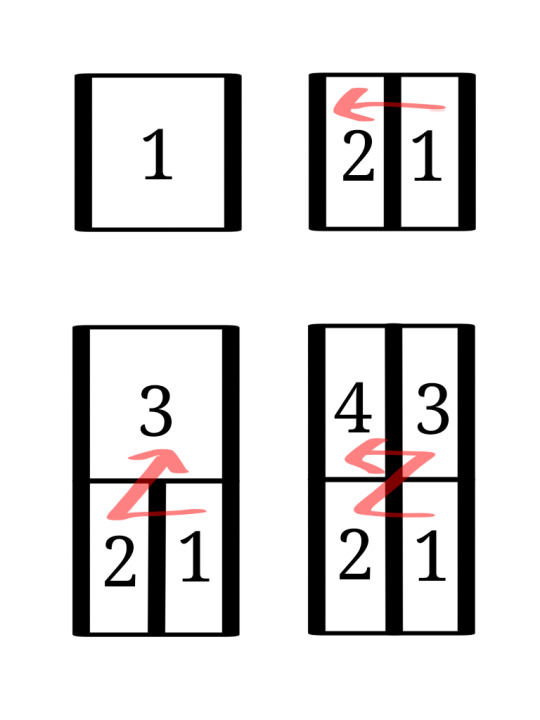
the flow of reading word-internally definitely follows the overall direction of writing (bottom-to-top, right-to-left) so broken down an entire word will usually look like this when written:

Seraphic written in longform will be written entirely using the alphabet. Spaces are put between words, punctuation and numeral symbols are still used, and tone diacritics may be included as well, but otherwise it's entirely spelled out in this way. Writing this way makes the text as a whole quite longer, and can come off as childish or imply you're a new learner of Seraphic, so shortform will usually be used in official contexts. In shortform, alphabetical letters are restricted to non-declined parts of nouns, adjectives, and proper nouns.
Class Cartouches

In Seraphic, there are seven noun classes: Solar (people), Astral (animals), Vital (plants), Terranean (places), Metallic (objects), Lunar (concepts), and Oceanic (everything else). Similarly, the writing system employs seven symbols called "class cartouches" to encode which noun class a word is in. This is drawn from this writing system's predecessor, the Aeonic Seraphic alphabet, that also used glyphs to notate class. These are the seven noun class cartouches:
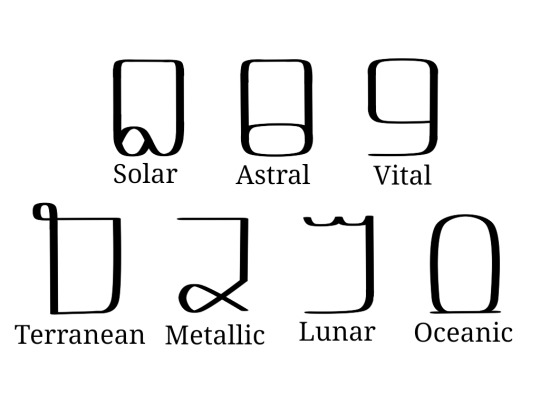
The thing about the class cartouches is, not only is it morphological, but it's also phonetic. A noun is never spelled out in its entirety, usually only part of it is. When a class cartouche is used, it's supposed to stand in for the class prefix itself without having to additionally spell the class prefix in the rest of the word. For example, in the word zājlux (tail), the "-jlux" would be spelled out, and the solar class cartouche would be drawn around it to stand in for the "zā-". Even though you don't write it, you still know it's there because of the class cartouche. Because of the nature of the noun class prefixes, and how many different forms they can take, it can be daunting to have to guess if you're supposed to pronounce a word with a "za-" or a "zo-", but there are patterns to which prefix (and thus, declension patterns), is meant to be read depending on what the following sound is.
Solar class
read as zā before f, v, s, z, c, j, pf, ts, tc and any cluster of two consonants (e.g. zāsā, zāfr, zājlux)
read as zō before x, ğ, h, ', and kx (e.g. zōxō, zōxur, zōğœcl)
read as zē in stressed syllables, and occasionally before consonant clusters (e.g. zēzmp'ux, zēzt'e, zēvasax)
read as s before vocalics (vowels and syllabic consonants), r, l, w, y, n, t, d, p', or k' (e.g. srāc, sēr, sōğœc)
read as ts before t', the ts replacing the t' entirely in pronunciation, for example tsn would be written as (Solar)t'n (e.g. tsn, tsā, tsłzaf)
Astral class
read as ğr before f, v, s, z, c, j, x, ğ, h, pf, ts, tc, kx, p', t', k' and and cluster of two consonants (e.g. ğrzles, ğrxur)
read as x before vocalics, r, l, w, y, ŋ, k, g, p', or t' (e.g. xūc, xŋox)
read as kx before k', the kx replacing k' in pronunciation (e.g. kxa)
Vital class
read as wā before r, l, w, or y (e.g. wāya, wārāc, wāwax)
read as wō before k', k, g, x, ğ, ŋ, or kx (e.g. wōk'ł, wōxur, wō'ōf)
read as wē before consonant clusters (e.g. wēzles, wējlux, wējlozln)
read as ū before n, m, p', p, b t', t, d, f, v, s, z, c, j, pf, ts, or tc (e.g. ūt'u, ūp'n)
read as w before vocalics (e.g. wē, wīn, wājr)
read as wī occasionally before consonant clusters (e.g. wīzya)
Terranean class
read as va before f, v, s, z, c, j, pf, ts, tc and any cluster of two consonants (e.g. vafl, vasērn, vasa)
read as vo before x, ğ, h, ', kx, and consonant clusters (e.g. voxāl, vodsā, vojrayux)
read as vu in stressed syllables and occasionally before consonant clusters (e.g. vujlux, vulvren, vuzajni)
read as f before vocalics, r, l, y, w, m, n, ŋ, p, b, t', or k' (e.g. fe, fruvn, fmağo)
read as pf before p', pf replacing p' in pronunciation (e.g. pfan)
Metallic class
read as ja before f, v, s, z, c, j, pf, ts, tc and any cluster of two consonants (e.g. jafa, javlni, jawaya)
read as jo before x, ğ, h, ', and kx (e.g. joxl)
read as c before vocalics, r, l, w, y, n, t, d, p', or t' (e.g. can, cya, cenaŋx)
read as tc before t', the tc replacing the t' entirely in pronunciation (e.g. tcłvr, tcāŋğl, tcū)
Lunar class
read as la before r, l, w, or y (e.g. lara, layeğr, lalel)
read as lo before k', k, g, x, ğ, ŋ, or kx (e.g. loxir, loğn̄, loxel)
read as le before consonant clusters (e.g. levp'ā, levren, lejt'ān)
read as li in stressed syllables and occasionally before consonant clusters (e.g. liwayi, lit'n̄, livasāx)
read as y before vocalics (e.g. yar, yu, yawu)
read as l/ł before n, m, p', p, b t', t, d, f, v, s, z, c, j, pf, ts, or tc (e.g. lce, łzēwok'u, lvulvren)
Oceanic class
read as a/ā before m, n, p', p, b, t', t, d, s, z, f, v, c, j, pf, ts, tc, w, r, y, l, and all consonant clusters (e.g. ap'i, āt'ē, ācèya)
read as o/ō before ŋ, k', k, g, ', x, ğ, h, and kx (e.g. ōxūr, ōxān)
read as aw/āw before vocalics (e.g. awun, awaf, awaman)
Of course these rules are not hard set, and there are several instances where a written word contradicts these rules or even when two words end up spelled the same, but for the most part these rules will generally be consistent for most written words. It seems like a lot to remember, but usually it's a thing that you eventually develop a sort of "ear" for.

Procedural and Plural Ligatures

The procedural and plural ligatures are additional glyphs used to mark, respectively, the procedurals and the plurals of a noun. The procedural are written at the bottom of the noun (since Seraph is written bottom-to-top and these are prefixes of course), and there are 12 separate procedural symbols in use. Similarly, the plurals, being suffixes, are written at the top of the noun and contain only three symbols (the singular is usually unmarked). They are as follows:
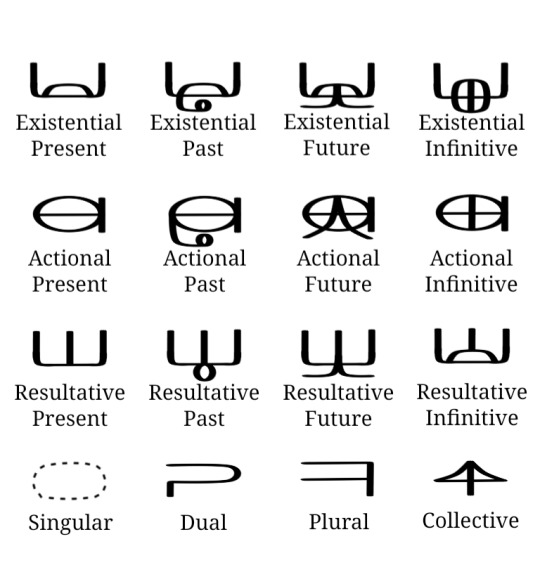
The plural ligatures attach to both nouns and adjectives freely, but in order for a procedural ligature to attach to an adjective, the adjective needs to be put in the oceanic class and subsequently written with the oceanic class cartouche. Additionally, if you want to write remote past/future forms for each procedural, you would need to attach the resultative present ligature underneath the preexisting past or future ligature (these conjugations haven't developed their own separate ligature forms, so they follow the tradition of using the resultative in addition as semantically that is where the remote forms originated). I don't really have a way to show you how to pronounce the plural forms, as even though the different pronunciations are pretty few they're actually pretty inconsistent on which one goes where. It's just one of those things you kinda have to already know. You can check the introduction to Seraphic post to see what forms the plurals can take, but otherwise it's basically, like, memorization. The procedurals on the other hand DO have a predictable pattern of pronunciation, but each tense has a different form based on what class and declension the noun is in, and with six tenses and seven classes each with at least three different declension forms, it's definitely something I can't summarize here. Again I HAVE to make a separate post for that because the declension forms are vital to knowing how to decline properly in Seraphic.
Preposition Glyphs

This section will probably be the easiest to explain really. The preposition glyphs are pretty easy to recognize. They're written in between words, attaching to both of them instead of floating freely like regular words are. There are 19 glyphs for the 19 prepositions, and they don't really change form. Sometimes, if occurring at the beginning of a sentence, they'll have one end sorta lopped off, but not everyone follows through with this convention. Here are the glyphs listed below:
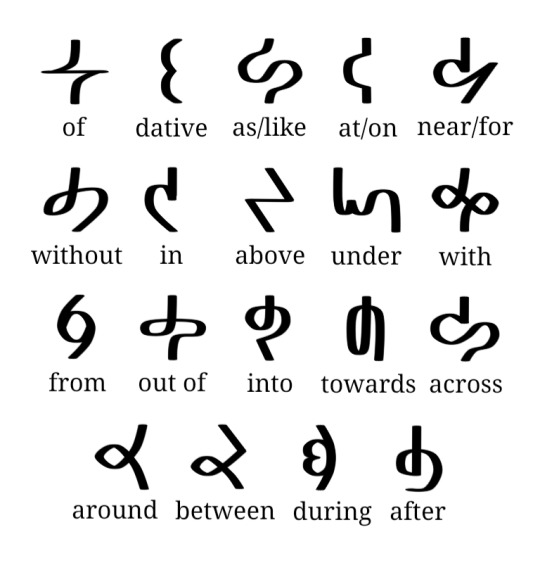
Two or more prepositions can't occur sequentially, it's a very one-at-a-time situation, although in colloquial speech you'll see two prepositions being used in certain instances.
Tone Diacritics

Seraphic is a tonal language, and luckily it has diacritics to indicate the tones. They frame the words on each size, being used on both nouns and adjectives where applicable. You'll usually see them in formal contexts like government documents and letters of address, on signs and boards and menus and any kind of display especially in highly populated areas, in use by those whom are just learning Seraphic and don't have a hang on remembering all of the tones yet, and just in any context where clarity of literacy would be important. In everyday colloquial text conversations and things the tone diacritics will be usually dropped as context is sufficient enough to know, although tone diacritics may be reintroduced to differentiate homonyms that are distinguished only in tone (e.g. lxal "power" vs. łxāl "day"). There are eight individually recognized tone diacritics:

The low tone is the base tone and is usually left unmarked, so there's no sign for just the low tone. When a low tone transitions to a rising or falling though, the low transition diacritic will be used to connect the two. Many of these diacritics are usually connected consecutively when a word requires it, flowing as if they're one larger tone diacritic. This can give a whole host of unique tone symbols, but for the most part, all of the tone symbols can be broken down officially into the 8 diacritics. There isn't a 1-1 correspondence between individual tone diacritics and syllables within a word, usually you can know from context and just knowing how the word is pronounced. For example, the word łxāl would be written with one high tone marker even though the word is two syllables, but it's meant to infer that the entire word is pronounced with an even high tone. Here are some additional examples:
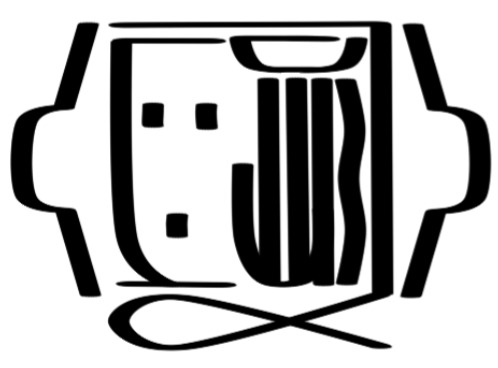
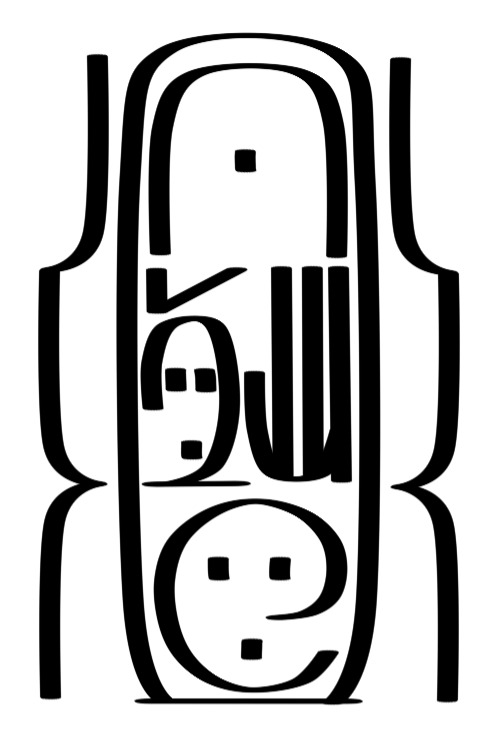
The top example is the word jalzègxa "chronicle". You can see that it uses the two low tone transitions to connect to the central falling tone, representing a low-falling-low relationship. The word below that is māzefādnu "hourglass". It employs a high-low-high, and then a high-low, with the last high-low meant to merge with the high-low-high. So truthfully it's meant to be interpreted as high-low-high-low. There's a lot of possibilities, but breaking it down will simplify what tones are being used specifically.
Numerals and Punctuation

This final section will discuss Seraphic numerals and punctuation. Now, unlike in most human languages which uses base-10, having 10 unique symbols to represent the values of 0-9, Seraphic uses base-16 and represents the values 1-16 with 16 individual symbols. In base 16, we would write 16 as 10, standing for one set of 16 and zero sets of 1. It's written in positional notation like arabic numerals, where each position represents a power of 16 (instead of a power of ten like in base-10). Here are the numerals:
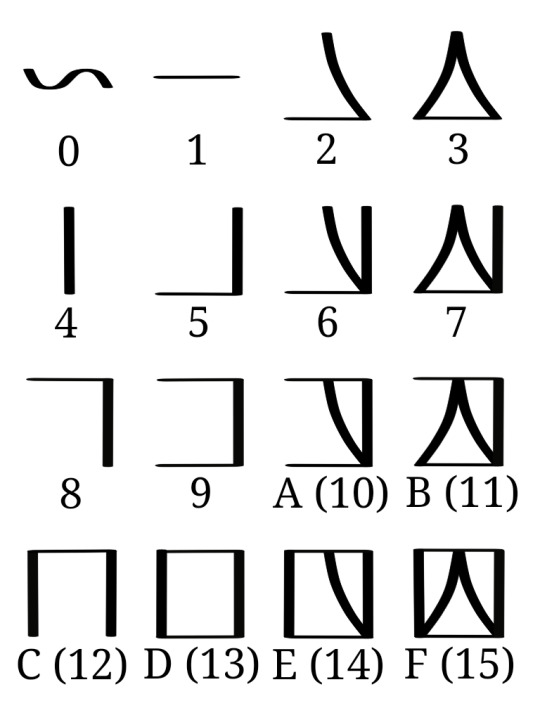
If you were to write a number like 299,792,458; you'd convert it into base-16 which would be 11,DE7,84A; and since Seraphic numerals are grouped in 4 instead of 3 it would actually be 11DE,784A. This is how you'd write that:
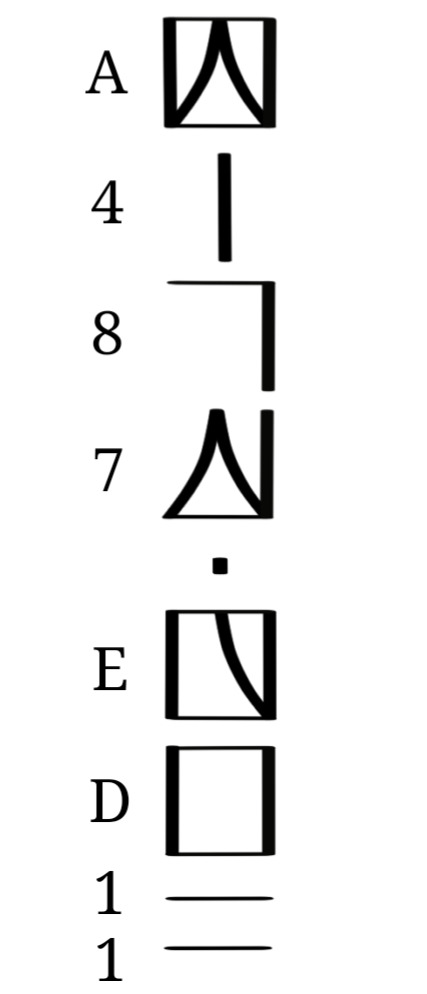
Both Arabic numerals and Seraphic numerals describe the same amount of things, they just group things differently. We group in sets of 10, they group in sets of 16.
As for punctuation, there are only 5 marks that's in standard use, and these are them:
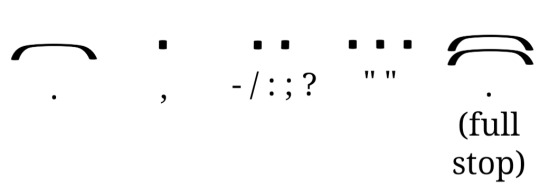
Single bar - separates individual sentences.
Single dot - separates clauses for clarity, separates numerals into groups of four.
Double dot - separates individual words such as in lists or replaces a single dot when separating clause groups.
Triple dot - Distinguishes quotes and dialogue, as well as highlighting names, terms, and titles.
Double bar - used to end full paragraphs/passages instead of a single bar.
Overall, that's pretty much everything I can detail about how the Seraphic writing system works! It's complicated but it was very fun to develop and boy was it satisfying to get it to work. Hopefully you'll now be able to decode a little better Seraphic writing, and maybe even write something of your own!

ŋKowīci cu-stux 'ōf tsa-levp'ā cu-zāsláf pi-lizt'n ğōdjasa! (Thank you all so much for reading!)
#conscript#constructed script#neography#conlang#constructed language#artlang#writing system#orthography#seraphic#collective seraphic#whoa boy this one is even longer#had to do a lot of writing and doodles for this#of course i needed them so itd all make sense#i needed to provide examples#either way i hope this made any sort of sense#ill provide the declension forms soon enough and that should be relatively shorter#idk if it'll be easier to explain though#eh whatever
42 notes
·
View notes
Text
GOD DAMN IT
I think I FINALLY caught something I had been missing. I was talking to my grandma today about language>spelling>alphabets>syllabic alphabets>Japanese, and I was just thinking about Welcome to Demon School, and...
I DON'T THINK HIS NAME IS ALICE!
ESPECIALLY after how much they harped on Agares looking like Endymion.
Alice=Arisu
BUT! Japanese has a syllabic alphabet! A-ri-su
AND! There is a Greek god whose domain is VERY convenient, and happens to be THE SON OF THE GODDESS OF LOVE AND BEAUTY.
He's not Alice, he's Eros! E-ro-su. A god who is JUST A LITTLE BIT FAMOUS FOR HIS ARROWS. The Romans called him Cupid.
So yeah, Asmodeus is Eros!
#asmodeus alice#azmodeus#azmodeus amuryllis#welcome to demon school Iruma-kun#mairimashita iruma kun#welcome to demon school iruma kun#azmodeus alice#asmodeus amaryllis
21 notes
·
View notes
Photo
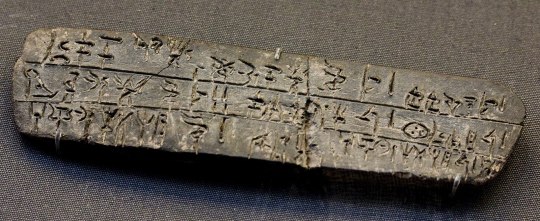
A clay tablet with Linear B writing, ca. 1400 BCE. Linear B was a pre-alphabetic method of writing the Greek language, which uses a syllabic system.
{WHF} {Ko-Fi} {Medium}
239 notes
·
View notes
Text
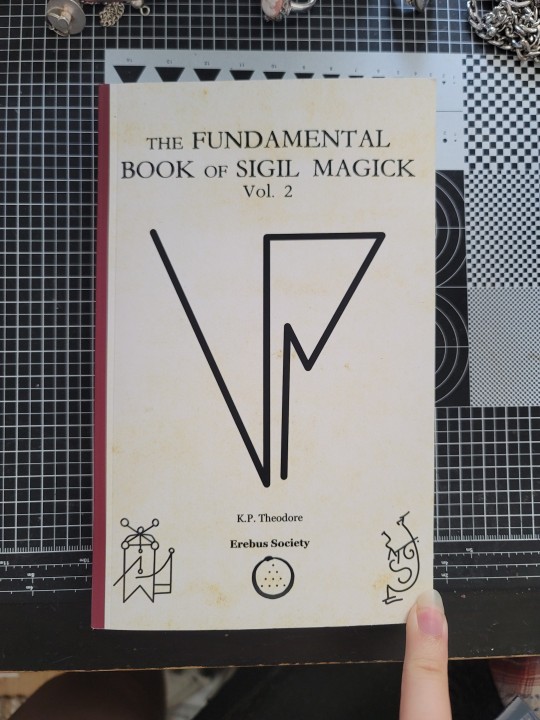
Okay so there is a book two of the sigil magic guide by K. P. Theodore and girl. GIRL! The other book didn't have any bullshit in it, and if you would like my quick thoughts on it check out this post, but this one introduces some bullshit.
Okay so the first two parts about what kind of sigils are there and how to make them is just the repetition of book 1 minus the pictorial method. That is fine besides this ugly ass sigil. Like girl i know you can use Adobe Illustrator way better than that cmon!
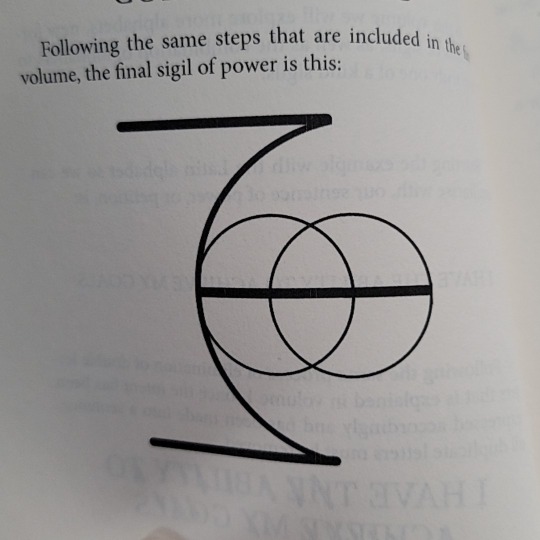
But anyways, here comes the bullshit. What isn't bullshit is the idea of using other scripts and languages other than English to make sigils. That is fine and if anyone figured out how to make sigils with a logographic or syllabic languages good for you and you can go ahead and use that.
Also this magi alphabet is fine it's just uh it's an occult way of writing Hebrew so that's iffy and idk if Theodore is Jewish. If this is your culture you're fine using this but still 💅

Here comes the bullshit:

This is NOT the enochian alphabet. THIS is the enochian alphabet

Then what is that alphabet then? The theban alphabet. What is the theban alphabet then in the book?
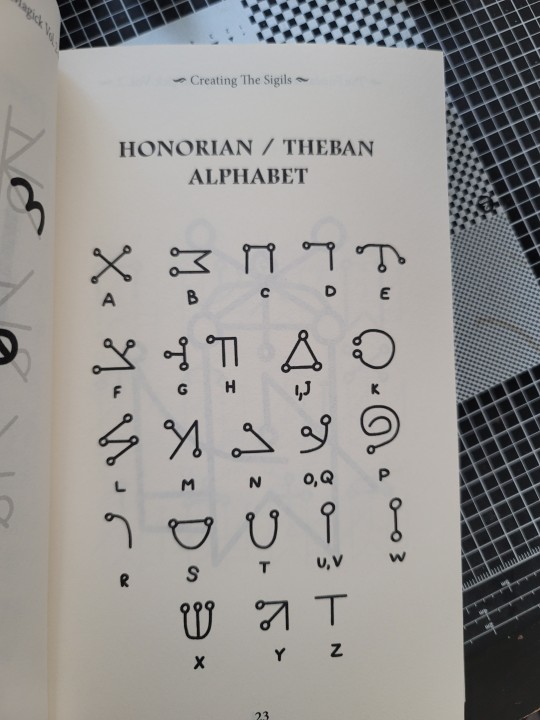
THIS IS NOT THEBAN. THIS IS CELESTIAL! oh boy then what is celestial???
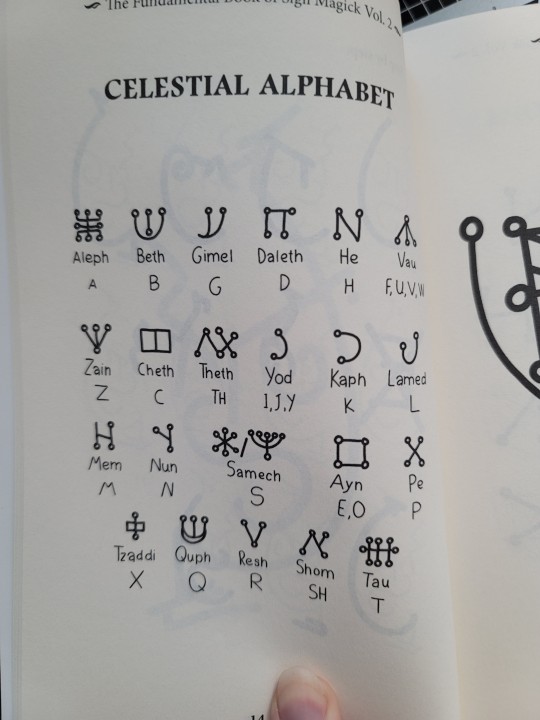
Do not let your eyes deceive you! This is not the celestial alphabet, this is the malachim alphabet. Both celestial and malachim are both a way of writing Hebrew for occult workings and I get it Theodore they look so similar! BUT YOURE AN OCCULT BOOK WRITER! YOU NEED TO GET THIS SHIT RIGHT! And by the way uh wanna know what the malachim alphabet is??? Before I start going insane???

Wh-WHAT IS THAT??? HUH??? WHERE ARE YOU GETTING YOUR SOURCES FROM THEODORE BECAUSE I CAN JUST FUCKING GOOGLE THIS SHIT TO FACT CHECK! I AM GOING TO BUY THAT OCCULT BOOK THAT YOURE APPARENTLY REFERENCING BUT FAILING TO EVEN REALLY READ IT!
Which is this
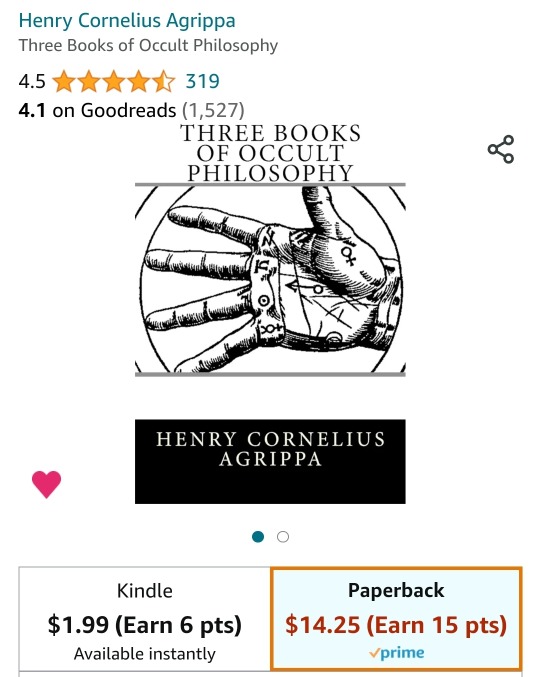
But it doesn't stop there. Oh no no no no! The bullshit hasn't stopped! It only begun! AND IVE RUN OUT OF HOW MANY PICTURES I CAN UPLOAD ON A POST VIA THE APP SO THIS IS GOING TO BE A THREAD!
please check the notes for the continuation of the bullisht
31 notes
·
View notes
Text
I keep thinking about the times that someone has looked at the idea of writing their language and gone '…yeah no I'm gonna fix that' or 'yeah I want a piece of that action' and made it happen, for any reason. And I'm gonna make noises about it for a little bit. Maybe highlight a couple of things.
You've got King Sejong in Korea going "OK. The script we're using now is hella complex and …Chinese. I want something that's easy enough for a farmer to learn. And maybe to pay his taxes with." And he works out hangul, neat and logical and frequent winner of Best Writing System awards if such things exist. (And then the nobles don't like it because how are they supposed to look smart if the peasants can write too?)
You've got Sequoyah, thinking the settlers he's doing business with might have at least one good idea in this whole 'talking leaves' system they're using. So he throws himself into working out a syllabary that works for the Cherokee language even when his friends and family think he's losing the plot or he's possessed or… Anything. But he hangs in there. Teaches his daughter. Proves that this is something worth it, and goes on to see the syllabary he created become official and used throughout the Cherokee Nation.
These are the best known ones. But how many are there out there?
There are systems where a missionary or someone similar's come into a place, and gone 'hm, Latin ain't cutting it for writing this' - the Cree syllabics and their extended Canadian family fall into this box, though there's at least some accounts that dispute the usual story. (Given that a lot of those sort of stories come down to 'so we can make a Bible at these people', it's fair to put a big old asterisk on them, but… they're a thing.) Getting away from that issue, though? There's local creators making a bespoke system for their language when the ones they'd picked up from outside just don't fit the sounds or grammatical patterns. Writing systems that can really belong to a language and its people.
While it's absolutely not my place to say whether something is good or bad - the only people who can do that are the language users and community the script was made for - there can't help but be a few that catch the eye. For example, I'm quite fond of the Ditema tsa Dinoko script - it's a pretty recent creation from South Africa as a script for a wide range of Bantu languages, using compact triangular blocks in a way that reflects traditional patterns from Sesotho tradition. From my outside perspective, it's an elegant script. It's just one example, though - there's many creators in Africa who have done similar things, sitting down and making a script that their language needs and that isn't being shoved on them by… yeah. Vai and N'Ko are the biggest examples but there are so many! Moving on, in Oceania, we find the Avoiuli text from Vanuatu, designed so that any one character can be drawn with one stroke in the sand… and elsewhere, the scripts being created to use with signed languages which haven't used them in the past…
If I were to try and go into all of them, it'd be a whole essay. And I'd probably miss some as I'm an outsider nerd without access to the deep literature on some of this stuff. Instead, I'll link to The World's Writing Systems as an index to browse through - unfortunately, it doesn't allow searching by how the writing system was created. But there are plenty of indigenous scripts listed there too that deserve their own deep dive. (The fact it lists con-scripts specifically made for fiction… eh.) Their icon comes from the Afaka script, for the Ndyuka creole in Suriname. A lot of the letters are quite pictorial in nature - including the 'ka' in WWS's icon. Gotta say, that's a way to make things memorable.
…anyway, that's my ramble for today. Just gonna wrap with this source which I haven't fully investigated yet, and Endangered Alphabets which isn't so much for deliberately constructed scripts but (unsurprisingly) for endangered ones in general, and as such plain deserves a link.
Now I go back to my own scribbling. Maybe I'll finish a con-script enough to show off one day. Even if one rather smaller in goals.
#writing#writing systems#language#constructed scripts#conscript#long post#i like words :3#just a ramble
43 notes
·
View notes
Text
Pixiv Recs. Obito's name
Have I already mentioned I love the Japanese fandom for all the wonderful comic strips and doujinshi? Oh, do I love it! They inspire me so much to create mine.
I haven't rec'd anything in a while because tumblr shadowbanned me for posting too many links last time xD But this one! Oh!
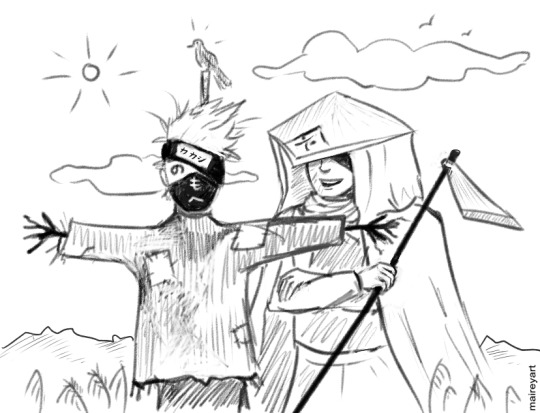
It's common knowledge in the fandom that the word KAKASHI means 'scarecrow', but what about OBITO? Ooooh, it has a meaning too ;)
But it's such a rare, outdated word that even (some) Japanese are shocked at the revelation--judging by the comments on Pixiv to this bittersweet and touching comic:
✏ "The name he threw away" by さあり.
Obito's parents discuss their soon-to-be-born son's name.
I was not surprised by the meaning only bc it had been the first thing I looked up in the dictionary when I'd learned about the development of this character after 12 years of being out of the fandom :D
Author's comment: "The man who spent most of his life under the aliases Tobi and Madara."
Translation:
Obito's Dad: Have you decided on a name?
Obito's Mom: Yes. I've searched books and thought about this a lot.
Dad: We're expecting a boy, so his name must be intimidating to his enemies and very powerful.
Mom: Powerful, yes. But I would like his name to be endowed with more than that… The name is very important. It is a gift given by parents to their child, the gift that stays with the child for life. If we disappear from his life someday, he will never forget our love because his name will still contain the intentions and thoughts we put into it.
(Book: Character Meanings)
Mom: Bringing people together and guiding them, leading the way for them… I want him to be such a leader.
Dad: Leader? You mean you want him to become Hokage?
Mom: He-he! He's your son after all. I wouldn't be surprised if he declares that one day!
Dad: Actually, I haven't given up on the idea myself yet!
Mom: My lovely child… Carry this name proudly, never forget it! And if you ever get lost on your way, reach out to it. In it is your essence.
(Book -- 首 SHU/kubi; kashira, osa; obito "a person who leads" (tousotsu suru mono)).
Mom: Obito.
_____
In the manga Obito's name is written with a syllabic alphabet, but the word may be written with a character too.
首 'obito' - a hereditary title (kabane) in Yamato-period Japan (250–710 CE). Obito means 'leader, commander', also something like 'the man in charge' (e.g. an obito could be the head of a 'bemin' family (a small clan subservient to a more noble clan in Yamato), or the man in charge of some duty, or a professional).
The word seems to have originated from the word combination "oo hito" (lit. 'big [authoritative] person'), but it was never written with these two charactes. In fact obito is one of the readings of the character 首 SHU/kashira/kubi 'head, neck', which hints to the meaning (just like in English the word head also means 'chief').
And the author of this comic saw great irony here. 'Leader' who renounced his own name along with the feelings his parents put into it 💔
I loved it.
#narutoart#pixiv#pixiv recs#naruto doujinshi#obito#obito uchiha#uchiha obito#naruto fanart#kanji#fanart#art#obito meta#dm me for more recs - i live on pixiv#and i know jp#a little bit#obito's parents#obimom#obidad#obimama#japanese characters
90 notes
·
View notes
Text
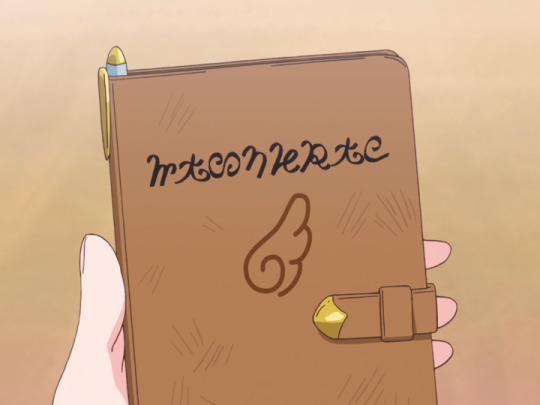
It’s so cool that Hirogaru Sky Precure’s “Skyland script” isn’t just gibberish. It’s clearly too sparse to be an actual constructed alphabet, but it’s definitely based on the Latin alphabet and Japanese syllabic structure.

The long and the short of it is that if you listen along when the characters read it, it’s not too hard to recognise the consonants. I have noticed some weird little quirks, though, like how the pure vowel kana each seem to have their own symbol, and they’re included even when they’re part of a long vowel or a diphthong, which I imagine would be tricky for someone who’s not familiar with Japanese vowels. And は is rendered as an H syllable, even when it says “wa”, which is just. Unpleasant.
#precure#hirogaru sky precure#yeah i'm the kind of nerd who pays attention to fake alphabets in cartoons for little kids
27 notes
·
View notes
Text
''Humanities are unnecesary and a burden in modern society!'' is a statement that will never be valid, at least not as long as we get takes as moronic as this one.

Losing my mind at this guy. Literally a google search away. They do not even try to hide it. And most people who see this, according to the numbers in the tweet, do agree!
But it gets worse.
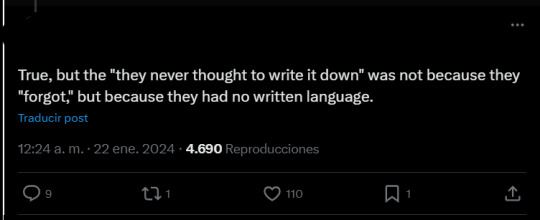
Those dumb guys in the primitive americas did not know how to write. Wait, what? What's this?
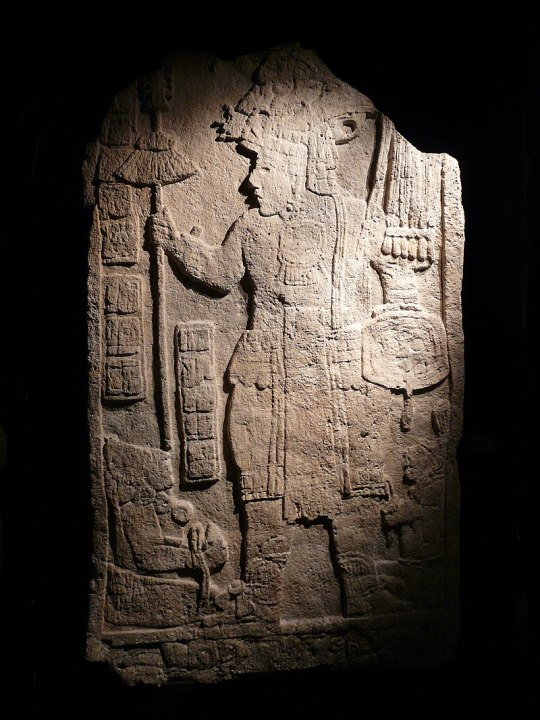
Wait, what? A mayan king commemorating an HISTORICAL battle by using WRITTEN GLYPHS? B-but they have no sense of time or writting! That must be a fluke!
Mmmh? But...?
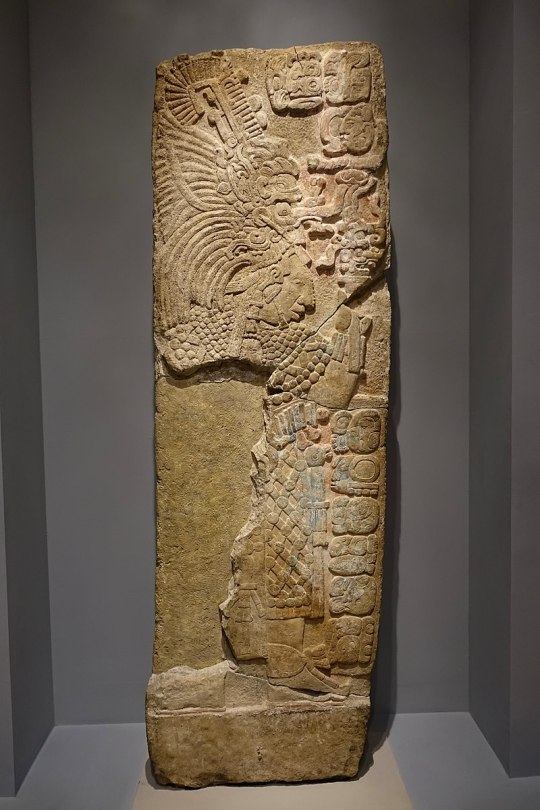
A stel portraying a maya queen, with again written symbols mentioning her directly?
''No, those don't count, they're just dumb short phrases, they are surely uncapable of writting down coherent tex-''

Wow, the Dresden Codex, dated from 11th century (mayans were not even at their peak here) writting down their religion, customs, different gods and even complex astronomical movements all-in-one!
Those stone age troglodytes were surely lucky to be able to keep time counts in the thousands of years!

Okay, you're right. Mentioning mayans is cheating because they do not use enough ''actual words'' only drawn ones!

Forget the fact they had a whole ass syllabic system, that experts have been deciphering for decades.
By this rule of thumb, the japanese are all illiterate because they do not actually use words, but abstractions in the form of syllabes. Maya greatest mistake was to do their particles too artistically or something.
The previous tweet implied there was going to be a threat debunking whatever rambling that person was on about, but it stopped there. So... okay.
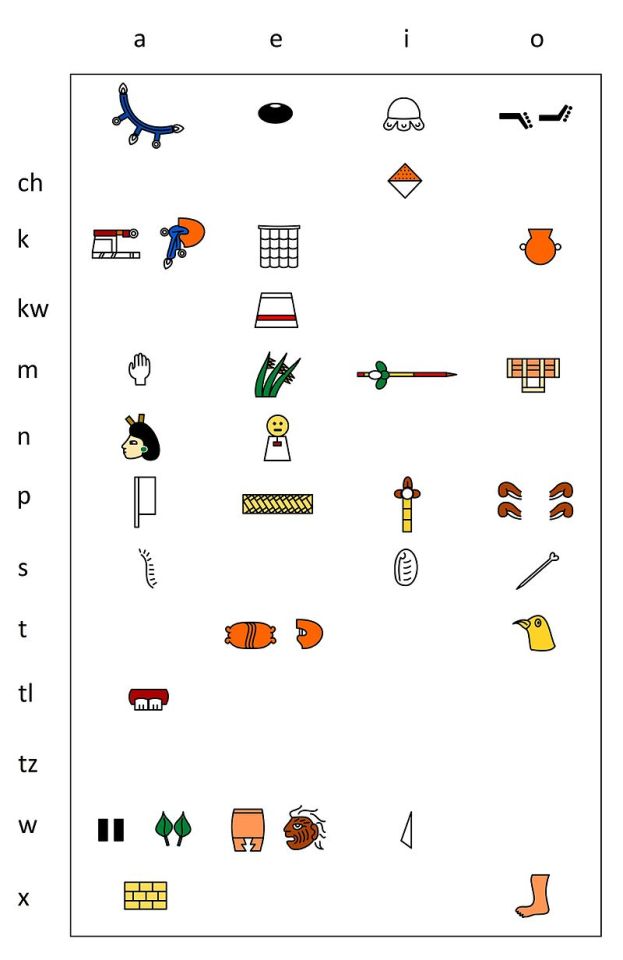
Regarding the aztecs, that would actually be somewhat accurate. They relied mostly on ideographic writting, but they also combined syllabes. They were still developing their language independently of the mayans. The process was interrupted by the arrival of the spanish crown.
However the writting of the aztecs is stupid and primitive because it doesnt resemble my latin alphabet enough AAAAGH! With such underdeveloped writting they wouldn't be able to write texts, let alone make librar-

Someone else answered, and it's literally the first google result right now, putting this curious image.
I wonder what it's trying to convey.

Solved. It's not a library because... well it's not! It's made of stone and has stupid scribblings stored. It's a nu-library!
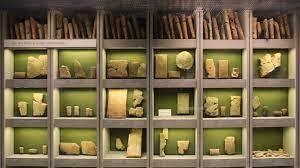
How are we going to tell Asurbanipal his assyrian library does not count because it's just not a library, because we need to dunk on the americas?

Forget the books. The real reason they're regressive is because they had no wheel.

They obviously relegated the wheel to toys, because after inventing, polishing it, even using it metaphorically in their intrincate calendars, they decided they didn't know how to use it beyond children toys. It was, again, a skill issue.
Regarding armor and weapons, did you know spanish conquistadores discarded their plate mails and used cotton armor from the natives, far better resistant to rust, and able to disperse slashing and piercing damage with comparable success? Far more comfortable, mobile, and less prone to well, cooking you alive.
How come, also, that Mayas and Aztecs knew each other? They lived in different zones of Mexico with frontiers separated by kilometers? Their trading routes (shared) must have been a stroke of dumb luck.

Apparently if you don't cross the whole ass Pacific/Atlantic Ocean, it does not count. By the way, did anyone in China, India, Africa, Europe or even Australia know about the Native Americans?
Conclussion: If you exclude Mayans, Aztecs, a myriad of other cultures in the Americas, their issolation to the rest of the continents, their set of beliefs, languages, structures, trade routes, traditions, libraries and use of the wheel among some other ''tiny'' advancements... well, you're right. They end being quite primitive.
I guess that's their fault. Maybe they should have conquered us first or some crap.
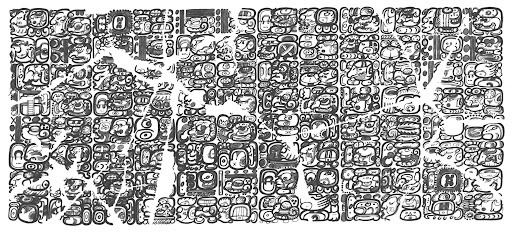
Those morons and their obscure scribblings.
PD: I excluded this person name in purpose. Do not send harassment to them. This generalized ignorance of America cultures does not radiate from a single person, instead is a shared set of common beliefs. We must combat the biased takes in constructive ways.
#language#culture#rant#anthropology#history#linguistics#maya#mesoamerica#glyph#dudebro#aztec#aztec culture#codex
4 notes
·
View notes